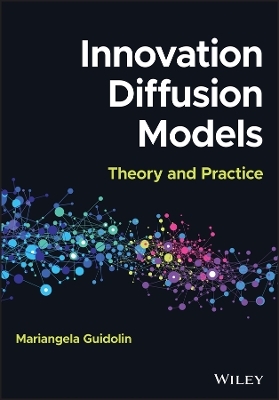
Innovation Diffusion Models
John Wiley & Sons Inc (Verlag)
978-1-119-75620-0 (ISBN)
Innovation diffusion models are statistical models that predict the medium- and long-term sales performance of new products on a market. They account for numerous factors that contribute to the life cycle of a new product and are subject to continuous reassessment as markets transform and the business world becomes more complex. In a modern market environment where product life cycles are becoming ever shorter, the latest innovation diffusion models are essential for businesses looking to perfect their decision-making processes.
Innovation Diffusion Models: Theory and Practice provides a comprehensive and up-to-date guide to these models and their potential to impact product development. It focuses on the latest product diffusion models, which combine time series analysis with nonlinear regression techniques to create increasingly refined predictions. Its combination of mathematical theory and business practice makes it an indispensable tool across many sectors of industry and commerce.
Innovation Diffusion Models readers will also find:
Real-world examples demonstrating the kinds of data sets generated by new product growth models and their potential applications
Discussion of the factors underlying the decision to select a given growth model for a particular product
Clear, detailed explanation of each model’s explanatory ability
Innovation Diffusion Models is an essential volume for practitioners in any field of industry or commerce, as well as for graduate students and researchers in business and finance.
Mariangela Guidolin, PhD is Associate Professor of Business and Economic Statistics in the Department of Statistical Sciences, University of Padua, Italy. She has published extensively on innovation diffusion models.
List of Figures xi
List of Tables xvii
About the Author xxi
Preface xxiii
Acknowledgments xxv
Acronyms xxvii
About the Companion Website xxix
Introduction xxxi
1 Theory of Innovation Diffusion 1
1.1 Basic Concepts and Definitions 1
1.1.1 Innovation 1
1.1.2 Innovation Diffusion 3
1.1.3 Innovation Diffusion Models 3
References 7
2 Innovation Diffusion as an Empirical Generalization: The Bass Model 9
2.1 Introduction 9
2.2 Bass Model: Theory 10
2.2.1 Closed-Form Solution 12
2.3 Model Estimation 14
2.3.1 Goodness of Fit 15
2.4 The Bass Model: Case Studies 15
2.4.1 Model Fit 16
2.4.2 Apple iPhone 16
2.4.3 RIM Blackberry 19
2.4.4 Wind Energy Consumption in Denmark 20
2.5 Recap 23
References 24
3 Innovation Diffusion with Structured Shocks: The Generalized Bass Model 27
3.1 Introduction 27
3.2 Generalized Bass Model: Theory 28
3.2.1 Closed-Form Solution 28
3.2.2 Structured Shocks 29
3.2.2.1 Exponential Shock 29
3.2.2.2 Rectangular Shock 30
3.2.2.3 More Complex Shocks 32
3.3 Generalized Bass Model: Case Studies 32
3.3.1 Model Fit 32
3.3.2 Apple iPhone 33
3.3.3 Apple Mac 34
3.4 Recap 39
References 40
4 Innovation Diffusion with a Dynamic Market Potential: The GGM 43
4.1 Introduction 43
4.2 Dynamic Market Potential: Theory 44
4.2.1 Closed-Form Solution 45
4.3 GGM 45
4.3.1 Specification of m(t) in the GGM 46
4.3.2 Communication and Adoption in the GGM 48
4.4 Generalizations of the GGM 50
4.4.1 GGM with Structured Shocks 50
4.4.2 GGM with Deterministic Seasonality 50
4.5 A Dynamic Market Potential Model with Network Externalities 51
4.6 GGM: Case Studies 53
4.6.1 Model Fit 53
4.6.2 Apple iPhone 54
4.6.3 Apple iPod 56
4.6.4 Samsung Smartphones 59
4.7 Recap 60
References 61
5 Dealing with Autocorrelation and Seasonality in Innovation Diffusion 63
5.1 Introduction 63
5.2 ARMAX Refinement: Theory 64
5.2.1 ARMAX Models 65
5.3 ARMAX Refinement: Case Studies 66
5.3.1 Netflix Subscriptions 66
5.3.2 Apple iPod 69
5.4 Recap 70
References 71
6 Innovation Diffusion in Competition 73
6.1 Introduction 73
6.2 UCRCD Model: Theory 74
6.2.1 More General Models in Competition 77
6.2.1.1 Lotka–Volterra with Churn Model, LVch 78
6.2.1.2 Competition Dynamic Market Potential 79
6.2.1.3 Competition Between Three Products, UCTT 80
6.3 UCRCD Model: Case Studies 83
6.3.1 Model Fit 83
6.3.2 Denmark 84
6.3.3 Australia 85
6.4 Recap 87
References 88
7 Estimation Methods for Innovation Diffusion Models 91
7.1 Introduction 91
7.2 Nonlinear Least Squares 91
7.2.1 Gauss–Newton Method 92
7.2.2 Levenberg–Marquardt Method 93
7.3 Confidence Intervals and Hypothesis Testing 93
7.3.1 Exact Inference 93
7.3.2 Asymptotic Inference and Linear Approximations 94
7.3.2.1 Prediction Intervals 96
References 96
8 Case Studies 97
8.1 Introduction 97
8.2 Sales of Smartphones 97
8.2.1 Recap 106
8.3 Music Industry in the US 107
8.3.1 Recap 117
8.4 Revenues of a Company 117
8.4.1 Recap 125
8.5 The Life Cycle of Tablets 126
8.5.1 Recap 130
8.6 Energy Transition in Germany 131
8.6.1 Coal 132
8.6.2 Gas 135
8.6.3 Nuclear 138
8.6.4 Renewables 141
8.6.5 Nuclear and Renewables 144
8.6.6 Coal, Nuclear, and Renewables 146
8.6.7 Recap 150
8.7 Growth of Video Conferencing 150
8.7.1 Share Price 151
8.7.2 Google Searches 154
8.7.3 Recap 157
8.8 Diffusion of a Scientific Paper 157
8.8.1 Recap 162
8.9 Diffusion of Internet Usage 163
8.9.1 Recap 170
References 170
9 Modeling a Diffusion Process 173
9.1 Statistical Modeling 173
9.2 To Explain or to Predict 174
9.2.1 To Explain 174
9.2.2 To Predict 175
9.3 Conclusion 176
References 176
References 177
Index 183
| Erscheinungsdatum | 04.11.2023 |
|---|---|
| Verlagsort | New York |
| Sprache | englisch |
| Maße | 170 x 244 mm |
| Gewicht | 572 g |
| Themenwelt | Mathematik / Informatik ► Mathematik ► Angewandte Mathematik |
| ISBN-10 | 1-119-75620-0 / 1119756200 |
| ISBN-13 | 978-1-119-75620-0 / 9781119756200 |
| Zustand | Neuware |
| Informationen gemäß Produktsicherheitsverordnung (GPSR) | |
| Haben Sie eine Frage zum Produkt? |
aus dem Bereich


